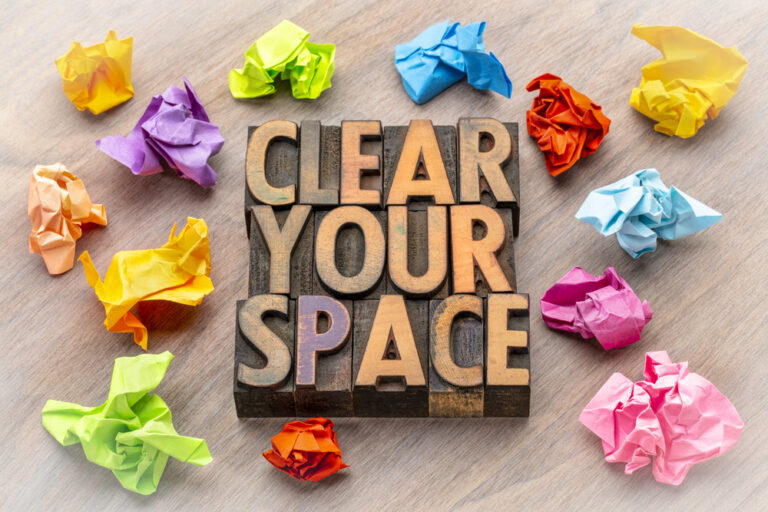Why Is Decluttering Overwhelming (And How To Overcome)
Are you feeling overwhelmed just by the thought of decluttering your home? Or does that feeling hit you when you actually see just how much clutter there is to go through?
Why is decluttering so overwhelming, and how can you overcome?
In this post, I list 5 reasons why decluttering can be overwhelming, each with its respective solutions and practical tips on how to overcome them.
Why is decluttering so overwhelming and how to overcome it
Here are the 5 reasons:
- Visual stimulation of clutter.
- Decision-making process.
- “What-if” scenarios.
- Huge amount of work.
- Emotional attachment.
Now let’s take a closer look and find the appropriate solutions for each of them.
1. If You Are Overwhelmed by the Visual Stimulation of Clutter
You may be confident about the decluttering task before you start. But after you pull everything out of the closet and realize the sheer amount of stuff you have, you feel swamped and don’t know what to focus on.
The solution is simple – don’t empty everything from your closet (drawers/cabinets…etc.) all at once.
You can try the following solutions:
Only declutter a small category at a time
Instead of pulling out all items from your closet/cabinets/drawers, how about focusing on one single category at a time?
For example, you can start with your closet’s “jeans” category. Pull out all the jeans from your closet, sort them through, decide which ones to keep and discard, and then put the “keep” jeans back in the closet. When you are done, move on to the next category.
This way, you’re only handling a smaller amount of stuff at a time. Since it takes a lot less time to complete, you can stay focused and, when finished, feel a sense of accomplishment. You will be motivated to move on to the next category with confidence.
Declutter and Organize simultaneously
I learned about this way of decluttering from Dana K. White’s blog:
You’ll need to prepare three things: 1) a trash bag for trash, 2) a box for items to donate, and 3) your feet, which means being ready to walk around your home.
Start by pulling items out one by one from a specific area. For each item, ask yourself: Do I want to keep this? If the answer is “No,” place it in either the trash bag or the donate box.
If the answer is “Yes,” then ask: Is this in the right place? If not, put it back in its proper spot immediately.
Since there is no pulling everything out and creating a bigger mess before starting to declutter, you won’t be overwhelmed with mountains of stuff. In addition, this method of decluttering allows you to start and stop at any moment.
2. If You are Overwhelmed by the Decision-Making Process
When decluttering, every item you own requires a decision, which means the decision-making process can be mentally exhausting if you have lots of stuff.
Here are some ways you can make the decision-making process less overwhelming.
Set Clear Guideline in Advance
By setting some clear guidelines about what to declutter and what to keep, you can reduce the number of decisions you need to make during the decluttering process.
Some examples are:
- Declutter any pants that are 2 sizes smaller than your current size.
- Declutter any t-shirts that you haven’t worn for more than one year.
- Declutter any kitchen tools/gadgets that have multiples and only keep one.
Practice decision-making skills in “easy” areas
Start your decluttering project with a “relatively easy” area, like a room with few sentimental items—such as the bathroom or pantry. This helps you practice decision-making.
Once you finish these “easy” areas, you’ll feel more confident and ready to take on the more challenging spaces.
3. You are Overwhelmed with “What If” Scenarios
Have you ever looked at items that haven’t been used for a while, and had all sorts of “what if” scenarios pop into your mind? You become hesitant, not wanting to make decisions you might regret later.

Here are some suggestions for being rational and realistic when going through your stuff:
Ask a simple question
If you ask open-ended questions such as “in what situations will I need this again”, your imagination will run wild.
Prepare in advance some simple questions to ask yourself when decluttering. Questions such as:
- Does it fit?
- Have I used it in the past 12 months?
- Do I like it?
These are simple questions that will help you focus on the task and be efficient throughout the declutter process.
Mentally Prepare for the worst-case scenarios
If you are unsure, ask yourself the following questions:
What is the worst thing that can happen if you needed something that you’ve already decluttered? How easy is it to buy it again, and how much would it cost? Can you ask to borrow it or rent it from someone? Are there any alternatives?
Picture yourself facing and dealing with the worst situation. You might see that it’s not a huge deal, and you can totally handle the situation if it ever happens.
4. If You are Overwhelmed By Emotional Attachment
When I was decluttering for my international move, I was overwhelmed by the sentimental attachment I had to all my stuff. I later understood, that I thought of my stuff as a representation of my past. Decluttering my stuff was like throwing away a part of me.
If you see your stuff more than just “stuff”, here are some suggestions to help you overcome the overwhelming feeling of sentimental attachment.
Memories are in your heart
A perfect example would be my son’s picture books that I gave away before moving. I felt sad to see them go, given the many wonderful memories of reading to my son during his baby/toddler years. However, after parting with them, I realized that all those vivid memories were already engraved in my heart, and I didn’t need the physical books to remind me of them.
Take photos
If you are worried about forgetting the memories after you get rid of your stuff, why not take photos of the items and create albums?
Find creative ways to display sentimental items

It is absolutely ok to keep items that are special to your heart. And instead of keeping them in a box in your closet, why not think of ways to display them?
Maybe frame that heartfelt letter from a friend or turn your favorite concert ticket into a cool wall decoration.
When you display these special items, you not only keep the memories close but also add a personal touch to your space.
5. You are Overwhelmed by the Amount of Work
Lastly, decluttering can feel overwhelming simply because of the amount of work involved. The idea of going through everything in your home can be paralyzing.
When you have a huge and complicating task, the goal is to make it smaller and simpler. Here are some ideas:
Declutter only 10 minutes a day
Set a timer and focus on decluttering for those 10 minutes only. By breaking it down into small, manageable time slots, you’ll be surprised at how much you can accomplish over time. As you gain confidence and momentum, you can gradually increase the time or the number of items you declutter each day.
Declutter One Item a day
Another baby step you can take, is to find one item to declutter every day. As long as you establish the habit and incorporate it into your daily routine, when you feel more confident to handle more, you can switch to a more aggressive method.
Stop shopping for new things
It’s a simple but powerful step that can help lighten the load. When we pause the influx of new items, it gives us the breathing space to focus on what we already have and gradually declutter without adding to the pile.
Conclusion
To recap, there are 5 possible reasons decluttering is making you overwhelmed:
- You are overwhelmed by the visual stimulation of clutter.
- You are overwhelmed by the decision-making process.
- You are overwhelmed with the “what-if” scenarios.
- You are overwhelmed by the emotional attachment.
- You are overwhelmed by the amount of work ahead of you.
By understanding the root causes of this overwhelming feeling and implementing practical solutions, the path to a simpler and more organized life becomes clearer.
Tackling the visual chaos of clutter is simplified by peeling back layers, focusing on small categories, and organizing as you go.
The daunting decision-making process becomes more manageable with clear guidelines and practicing in less challenging areas.
Rationalizing the “what ifs” involves asking simple questions and envisioning worst-case scenarios realistically.
Overcoming emotional attachments is achieved by recognizing that memories reside in the heart, capturing them in photos, and creatively displaying sentimental items.
Lastly, addressing the overwhelming amount of work can be eased by dedicating just 10 minutes a day to decluttering and taking a break from shopping for new items.
I hope this article is helpful to you!






